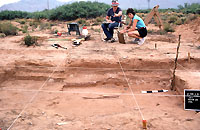
Crew chief Rob Vantil points out the progress in the excavation
of Room 22, one of the deeper pithouses.
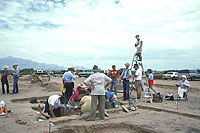
Ken Keller, one of the school's photographers, perches on a
ladder to record the excavation of Room 7.
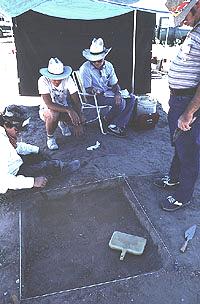
Excavation stops while everybody seems
to be reflecting on the finding of an "ancient"
dust pan.

Excavator looks over the artifacts just found as he prepares
field notes.

Jay Sharp, photographer for the fieldschool, examines
rock art in The Franklin Mountains.
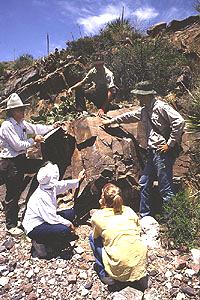
Mike Bilbo and ranger from Hueco Tanks discuss Pueblo period
petroglyphs in Fusselman Canyon.
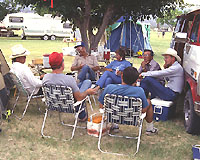
Yes, there are trees in west Texas, and
the campground was a great place to gather and talk—although
the nearly constant drum of generators from the nearby electric
plant did get tiresome.

Lab Director Jack Hedrick discusses pottery
of the El Paso region in one of the afternoon talks.
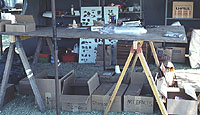
A well-stocked and well-organized lab.
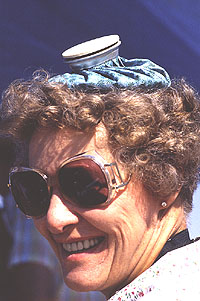
Janice Keller keeps a cool head while digging.
The food was excellent, and these Job Corps
chefs and trainees received many compliments. One plate just
wasn't enough for Jim Schmidt.
|
The 1986 TAS field school was billed as the
"just-barely-in-Texas TAS field school," as it was within
El Paso and only a few miles from borders with New Mexico
and Mexico. In addition, the archeology was different from
that experienced at most TAS field schools because it dealt
with cultural remains tied to Southwestern traditions. Adobe-walled
rooms, painted pottery, and turquoise jewelry were the draw
of this field school, and participants in the field or in
the lab were enjoined to learn about pueblo culture.
Fieldwork centered on the site of Firecracker
Pueblo. The investigation of this site had begun in 1980,
and by the time of the TAS field school, much was known. A
pueblo had been identified that consisted of no more than
20 rooms including habitation rooms, storage rooms, and a
large communal or ceremonial room. A number of somewhat small
and isolated rooms had also been found, but their relationship
to the pueblo was not clear. Outside activity areas had been
investigated to a limited extent, and this revealed a variety
of features and considerable trash. In general, this site
appeared to be typical of the many hundreds of other small
pueblos in the region.
The TAS field school added considerably to the
knowledge of the site and helped focus investigation in following
years. During the field school, additional rooms of the pueblo
were excavated, many isolated rooms and pithouses were identified
and several excavated, and outside areas and features were
delimited and examined. As a result of the field school, an
occupation that predated the pueblo was recognized, architectural
forms (pithouses) not previously noted for the pueblo period
were documented, patterns of outside features and activities
were being defined for the first time for a site of this period,
and cultural materials and special samples were retrieved
that helped make this site the most intensively and best documented
pueblo site for the region.
In addition to the excavations at Firecracker
Pueblo, participants assisted the Texas Parks and Wildlife
Department (TPWD) with a survey of lands in the Franklin Mountains
west of the pueblo and helped with the investigation of a
mission in the Rio Grande Valley. The survey directed by Ron
Ralph of TPWD focused on recording mining camps, caves and
rock art sites that were known but poorly documented. Dr.
Rex Gerald of the University of Texas at El Paso ran test
excavations at the late seventeenth- to eighteenth-century
site of Mission Socorro. This mission was for Piro Indians
brought to El Paso from New Mexico at the time of the Pueblo
Revolt.
Other activities associated with the field school
included tours of the rock art at Hueco Tanks State Park,
a tour of the Old Mission Trail, visits to museums, and afternoon
and evening lectures and discussions, as well as tasting the
border life through shopping and dining in El Paso and Juarez.
Craft activities, a visit to the Tonka toy factory, and basketball
games made life more enjoyable for the young ones, and some
adults. As with other field schools, guitars and voices straining
for unison could occasionally be heard. E. Mott Davis, of
course, closed the field school in his traditional way.
The food was better than that at some field
schools, courtesy of struggling new chefs made available through
the Job Corps. The campground was convenient and worked very
well—it would have been perfect if it weren't for the
constant hum of generators at the nearby electric plant. Carol
Hedrick spearheaded arrangements for the field school. Camp
boss was Gene Collins. Lab director was Jack Hedrick. Field
supervisors were E. Mott Davis and Ann Fox. Just about everyone
who attended had a role. It was a bit amazing to see nearly
200 people assemble, live together, and disappear within 10
days.leaving only footprints and a whole lot of memories.
To become a part of TAS and experience the fun
and education at field school and other events, visit www.txarch.org.
Now in its 73rd year, TAS is one of the oldest and most successful
archeological societies in North America. They offer training
for anyone interested in archeology, including special programs
for teachers and kids.
Early morning and TAS members disperse
to their units at Firecracker Pueblo.
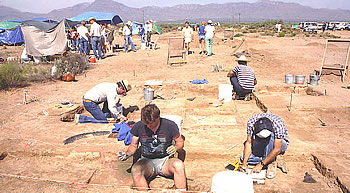
Looking west, from the area of Rooms 7
and 8.
Excavations in progress; the green shade tents provided welcome
shade, but didn't improve the lighting for photography.
Excavations in progress.
Bob Smith and others in the foothills of the Franklin Mountains,
surveying land for Texas Parks and Wildlife.
James Everett directs the children's group in the first work
in Room 7.
Part of the lab crew cleaning artifacts.
|
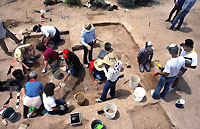
James Everett and his crew midway in the excavation of Room
7 of the pueblo.
Click images to enlarge

E. Mott Davis considers the layout of excavation units to test
the western part of the site.
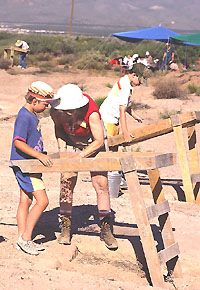
Young or old, everyone screens.
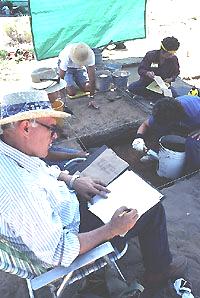
Crew chief Bill Parnell taking time to keep up with notes.

The rock art: mountain sheep with spear, a late Archaic
style pictograph.

Making whistles was one of the craft activities
for the youth group.

By the end of the field school, Camp Boss Gene Collins
needed a hat to remember his name. Keeping things running
smoothly was no easy thing.
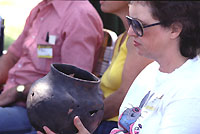
Afternoon talks provided an opportunity for "hands on"
presentations of the archeology of the El Paso area.
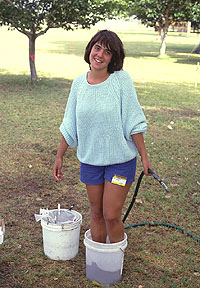
This is called getting into your work—or
cooling off West Texas style. One of two teenagers whose responsibility
was the processing of flotation samples.
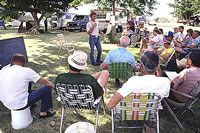
Supervisors and crew chiefs meet with the
field director, Tom O'Laughlin, to review activities and findings
of the day.
|